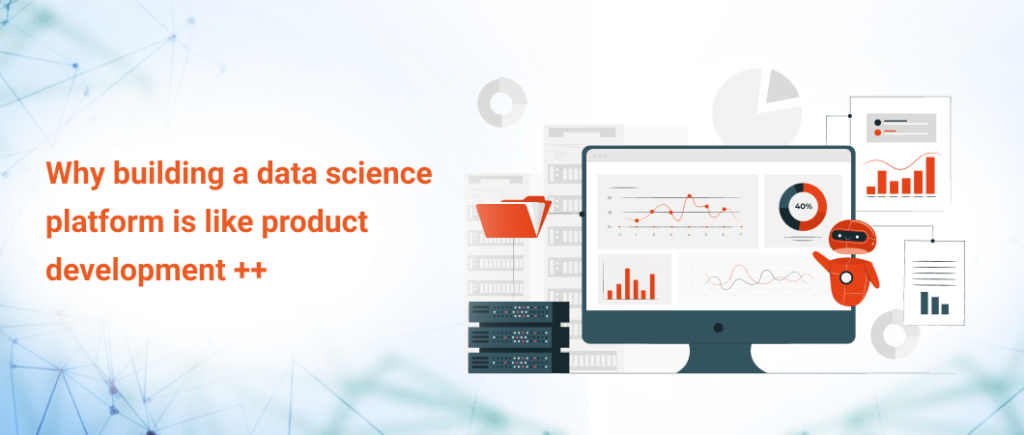Last updated on May 10th, 2024
There is a saying that goes “there is more than one way to skin a cat”. This might be a tough sentiment for proud cat parents but in this century this saying is quite accurate in the context of data.
Today, data is a valuable commodity. Organizations realize that the answer to their most pressing challenges lies in data. It is true that while many data problems can be solved using a python script, a terminal command, or a spreadsheet + report combo, the challenge emerges when the volumes of data expand and your organization needs scale, speed, and consistency.
While data analytics was the rage some time back as a solution to this challenge, the growing variety of data and its rising importance have shifted the focus now on data science. Organizations are turning to data science to glean insights from huge volumes of structured and unstructured data employing approaches that range from statistical analysis to machine learning. Data science helps translate data into value and gives the massive volumes of data that organizations collect a purpose.
The data science challenge
While data science is all about advanced analytics, most data scientists spend their time on data wrangling. Only a limited amount of their time and resources are dedicated to advanced analytics which included building machine learning models and performing iterations to these models to account for changes in the source data. What organizations need to power their data science efforts is a robust and comprehensive data science platform that can help data scientists to do their magic.
However, developing data science platforms is quite unlike any other product development. Along with the usual suspects like features and functionalities, here are some of the things we must focus on when developing data science platforms:
Understand the platform and data dynamics
Our recent experience in building data science and advanced data analytics platforms showed us that developing these platforms need more than the obvious technology and product development skills.
You also need the ability to tap into the mind of the data scientist to understand how the platform would treat the massive volumes of data it’s supposed to crunch. Developers can often be underequipped to handle the complexities that emerge from the use of elements like real-time timestream data.
Developers also have to understand the many data complexities while accounting for the unique needs of a data science platform. They must ensure that it accounts for elements like network-driven throughput and other influences of the platform. As such, product development teams must get into the mind of the data scientist to identify the unique conditions the platform will have to support and operate under.
Comprehensive Testing
Creating a comprehensive testing strategy is also a significant challenge when developing data science platforms. This is partly because testing here must address the platform as well as the data and how the data moves, i.e the network-driven throughput.
As testing progresses, paying attention to the data behavior at every stage and ensuring that the data is accurate every step of the way is critical. Testing the efficacy of data manifestation also becomes a crucial consideration when developing a data science platform.
Testing the accuracy of the devices or systems generating the data is another important factor and ensuring data integrity across the entire cycle becomes essential during testing to ensure data integrity. Ensuring all that, while addressing real-time data is a dynamic that needs close attention.
Evaluating data fidelity
The information output from the data science platform is proportional to the quality of the data input. So, if it’s garbage in, then it will be garbage out.
While ensuring that a data science platform is highly usable, ensuring the quality of data, and making sure the data fidelity, accuracy, and validity remain uncompromised at every step are critical. Evaluating how the data is processed also plays a significant role here.
It is also important to focus on maintaining the overall efficiency of the analytics process while testing the validity of the output from the perspective of aptness. Apart from ensuring that the data in use is appropriate while checking output validity, it is equally essential to remember to ensure that it is fair and unbiased.
Beyond functionality towards efficiency
As mentioned, getting into the mind of the data scientist is essential to build a robust data science platform. While functionality is paramount and user experience must be taken into consideration, a data science platform must make sure that the workflow extends beyond functionality and also maximizes efficiency.
Anticipating machine learning workflows requires planning, time, and effort. Understanding the business use and domain can play a massive role in making the right technology decisions to drive efficiency.
Organizations need to work on understanding the data first when building a data science platform. Determining data structures, defining data governance, and capturing a single source of truth become important touchpoints to evaluate and address. Along with this, it becomes important to understand how the platform will evolve. Using a microservices architecture to build the platform helps to future-proof it to a great extent.
We need to be ahead of the curve and anticipate how the needs from the platform could evolve to make sure it can develop along with the growing needs of the organization. It pays to remember that to become a data-centric organization, we need to enable the business users to leverage data as easily as data scientists. For this, democratizing data science is essential and developing a democratic platform that helps business users become more data-driven in their approach becomes crucial. That’s a lot to take in. And it’s clear that developing data science platforms is a product development and testing task of a different scale altogether!



